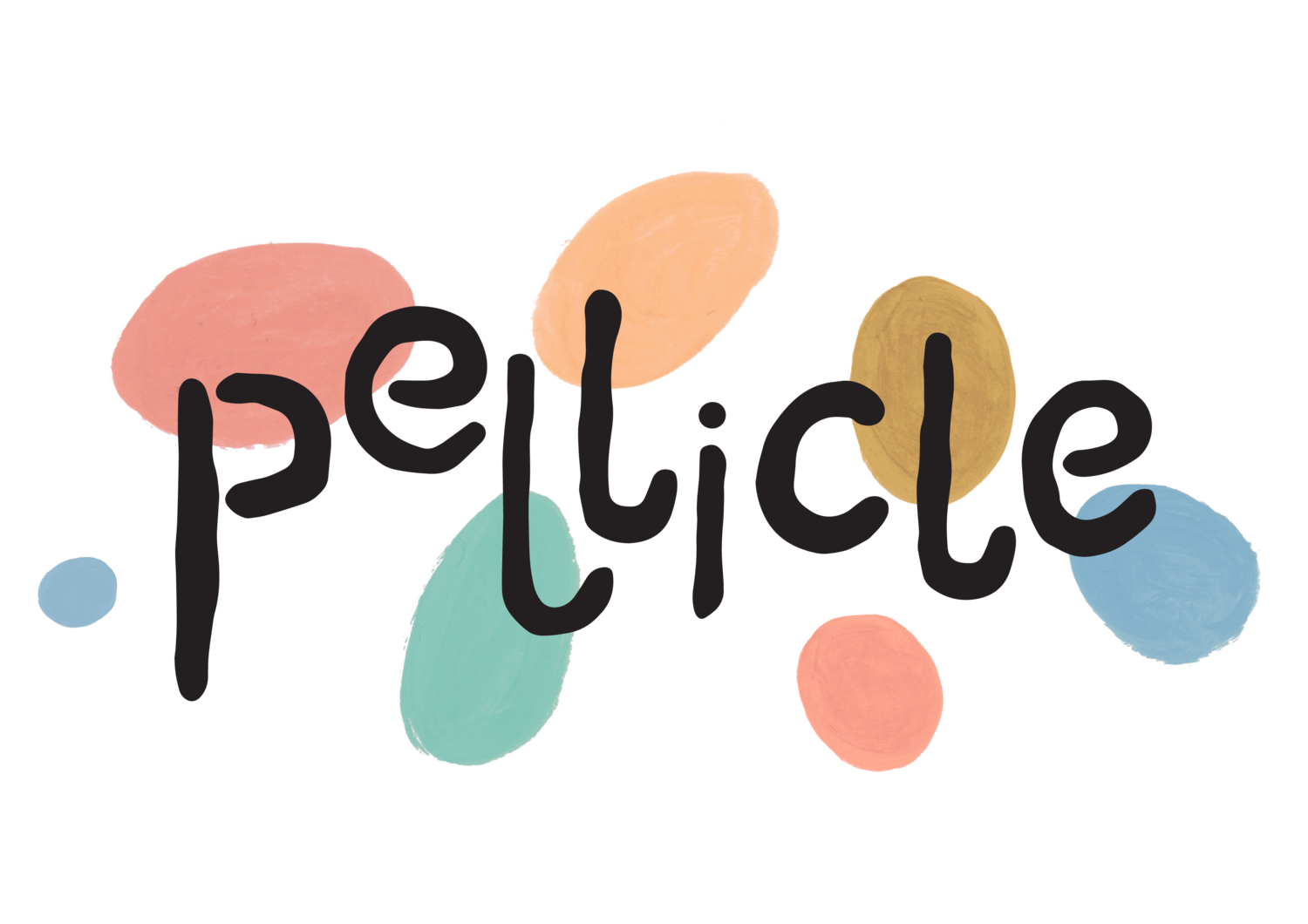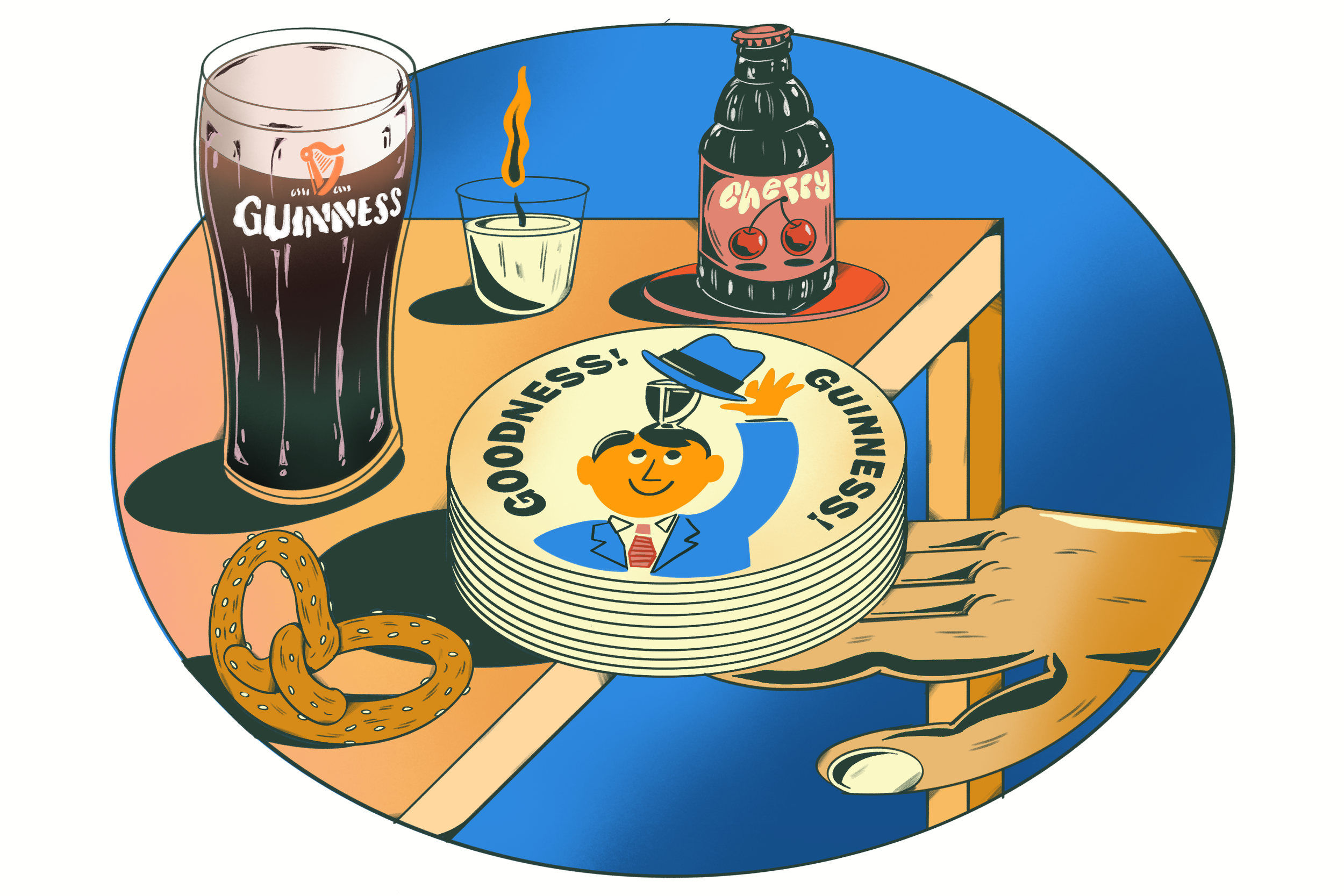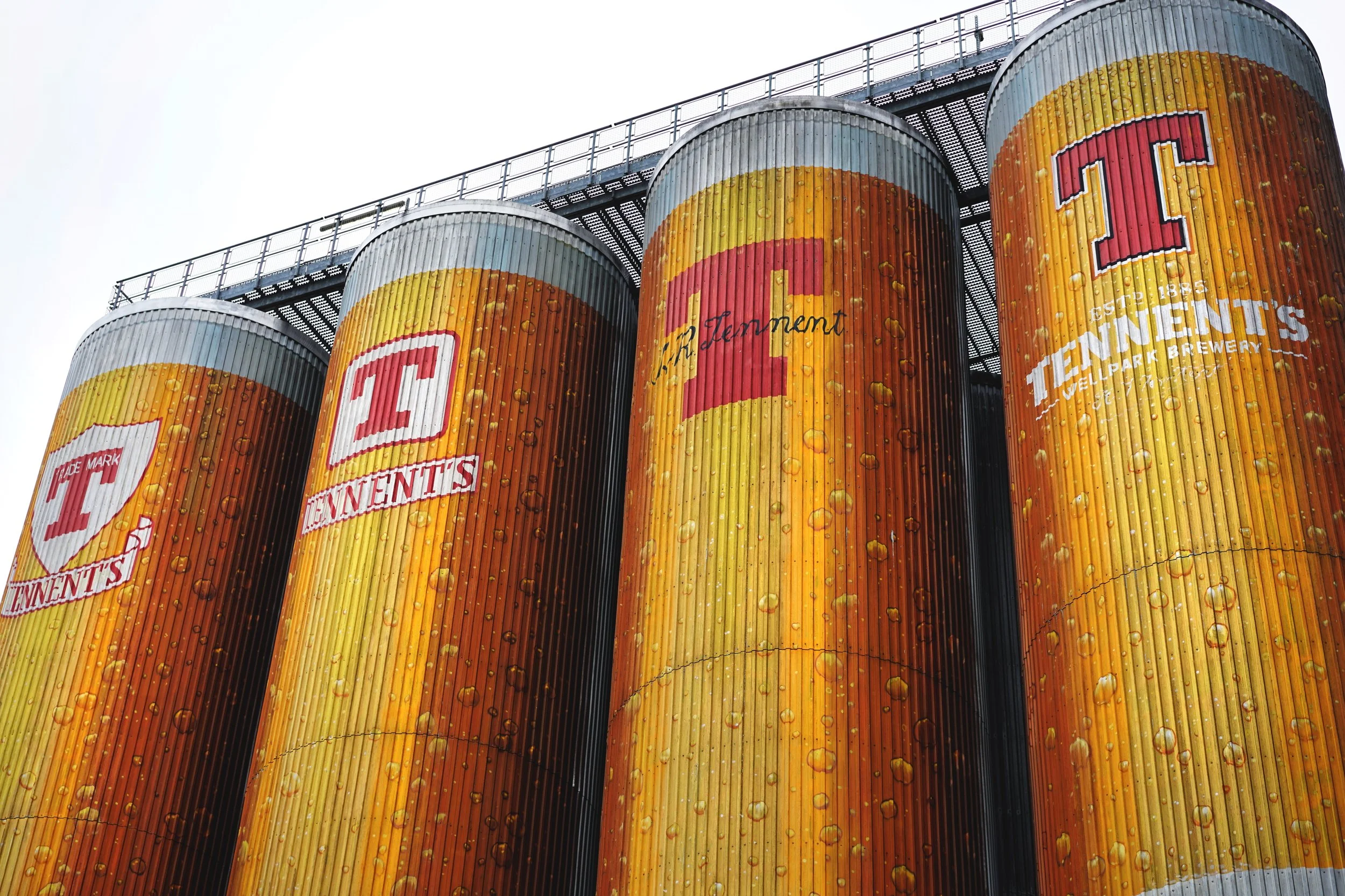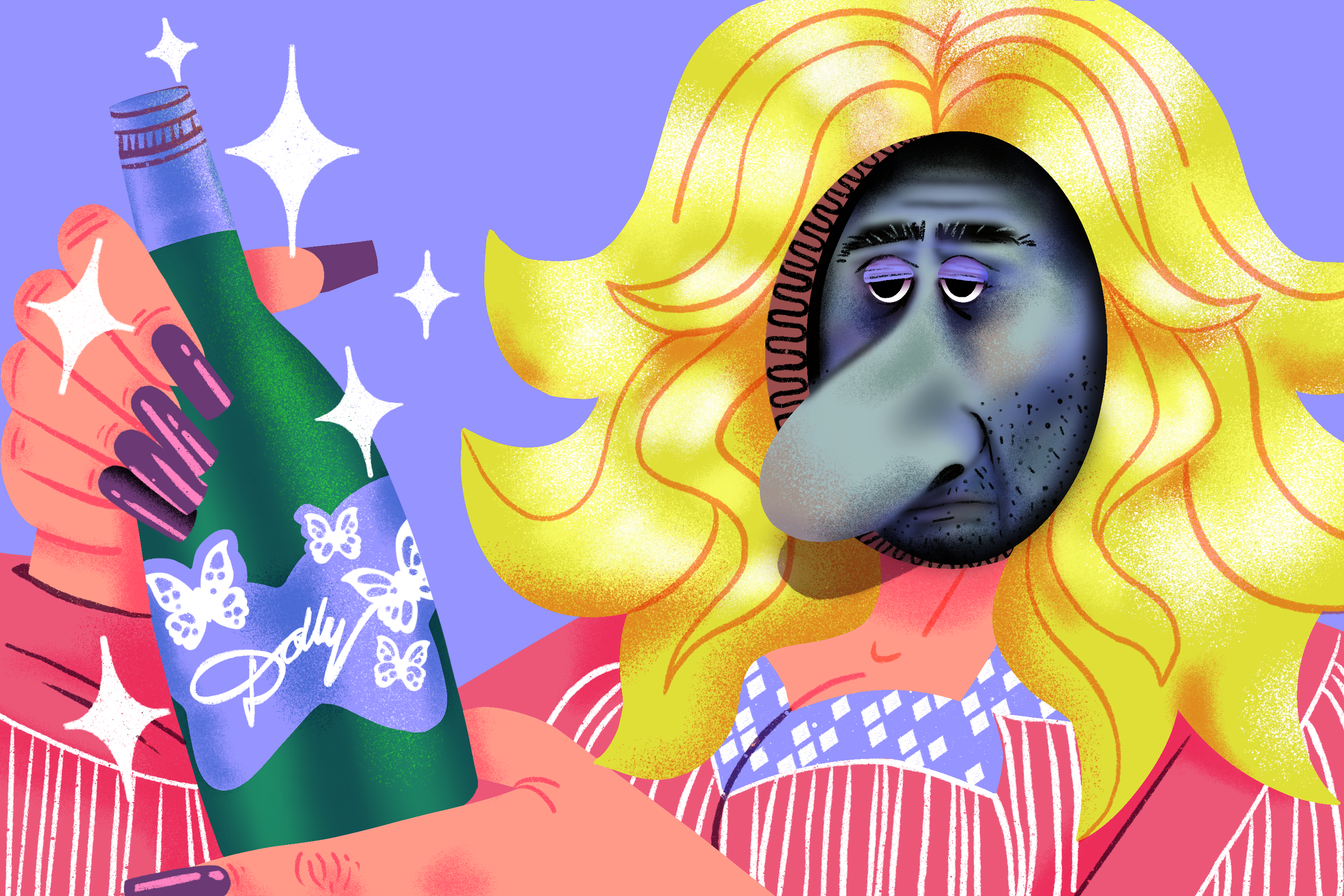The Wood That Drank The Heart — The Love and Life of Beer Mats
There is a theory I’m working on, born from over a decade of hospitality work, that the things a society pays the least attention to often have the most to say. To be discarded and dismissed, yet to exist and to be negotiated with regardless, can tell us something about the way habits, tastes, and social patterns have formed. If only one takes the time to listen.
Let’s use a beer mat as an example. A small pile sits on my desk whilst I write: vintage Double Diamond and Babycham given to me as gifts by friends—‘I saw these and thought of you’—a Beamish emblem from a trip to see family in Ireland; another of a brewery I associate with a recent romantic encounter.
When I am nervous I trace their cardboard circumferences with my finger. They punctuate the bar I work in, propping up tables, ripped into shreds by skittish or destructive hands, knocked to the floor, stolen as mementos. They see so much, these beer mats. They suffer for it.
It wasn’t always like this. This garish accentuation of disposable coasters strewn across our third spaces, coveted by few, taken for granted by many, discarded by more. An evolution has occurred and an evolution must be considered.
It begins with temperature, so I should, too.
A cooled liquid greets a warmer glass and the glass becomes cool in response. A sign of respect to some, straightforward physics to others. The surface of the glass submits to the lower temperatures of its contents and now it is the glass’ turn to assert dominance. It’s all cause and effect, you see.
Air behaves differently to glass: it doesn’t comply so neatly. Instead, air molecules change in protest, water droplets forming, clinging to the glass’ surface, condensing in defeat. And as these droplets slowly run down the length of the glass they’ll eventually meet another surface—a table, let’s say.
Here the destruction continues. The water droplets penetrate the table, forcing their way in, bruising the surface as they do so: soaking into the varnish or stain and forcing it to the outer edges, leaving a double-outlined ring. The glass may be moved but the marks remain. One mark may be forgiven, forgotten, but many marks make an endemic, a sight for sore eyes, countless hammer marks on a jeweller’s workbench. Protection is required, it can’t go on like this!
““It’s a simple fix, the coaster, but one that speaks of priorities.””
But what to stop? When drinking a refreshment it must be cold, the receptacle too. The air must be warm and hospitable, a table must be provided, also. It’s Customer Service 101. The condensation, then. The only element not required, bar the laws of thermodynamics and fluid mechanics.
It’s a simple fix, the coaster, but one that speaks of priorities. Nothing has been compromised, the experience dutifully preserved. Excess and disposability once again joining hands to create convenience.
***
On YouTube I watch dozens of videos showing me the manufacturing of beer mats. I become mesmerised by the undulating mechanics of it all.
One shows the dismembered limbs of spruce trees from Germany’s Black Forest gathered together in neat cylinders before they are moistened with water and tumbled together in a vessel to peel them of their bark. I am told that for every tree felled, three are planted in its place. These peeled logs are then ground down into chips before being mixed with more water, creating a thick, lumpy gruel. Offcuts of old beer mats are added here, creating a gloopy pulp that will eventually form the central core of new beer mats.
Illustrations by Adam Menzies
Whilst this is happening another pulp is being created with recycled paper, once again mixed with water, this time forming a lighter, ink friendly form. Water, starch and wood. That’s all that’s required.
These two pulps are sprayed onto a mesh, forming expansive sheets and layered over one another, the lighter paper pulp sandwiching the coarser wooden one, only to be spun, pressed and dried by a series of cylinders. They’re then trimmed into boards with military precision, in preparation for a cutting and printing process implemented to the last millimetre.
Artwork is printed, shapes are cut, beer mats are created. Millions are made day in, day out like this, over and over again, packaged and distributed to pubs, bars, and venues worldwide and placed on a table, waiting for our arrival.
Garry Hobson is the managing director of KATZ UK, a German-based manufacturing company who specialise in beverage coasters, or beer mats to you and me. Garry has been working in beer mat production for decades—on our video call I show him the Double Diamond coaster on my desk and he responds “I think I printed that”—so I get in touch to see if the notes I made from my time on YouTube are industrially accurate.
“We get asked sometimes, if we make a coaster thinner, how many trees do we save?” Garry tells me as he talks me through the process. “And the answer is none: trees are not cut down for coasters, and so from a sustainability point of view, it's a byproduct. A byproduct of the wood that's cut for the building industry. What's left is a very soft wood, which is great for us because we can grind it without using too much energy.”
But don’t be fooled by all these references to soft, gloopy pulp. Beer mats are hardier than most people give them credit for.
“Don't forget, beer mats need to both absorb up to 300 times its own weight in liquid and represent the brands,” says Garry. “The quality of print that we're able to produce reflects the high quality print that you see on the labels, on billboards, what you see on TV, radio advertising, so it complements the whole journey… We have to ensure that the whole branding flows right through.”
***
Western cultures have always been precious about appearances.
Be it tablecloths, napkins, doilies, the need to cover and preserve, to make up and to manipulate has been present in drinking and dining etiquette for centuries. Coasters began to crop up around the mid-18th century; a slidable foundation for wine bottles so they could be literally coasted across the table once the serving staff had retired. Indolence breeds innovation and all that.
Earlier iterations of beer mats were often found on top of the glass, not beneath it, as a deterrence for insects, a signal not to clear the vessel away. It was the late 19th century in Germany that saw the beginning of beer mats as they are known today. Friedrich Horn, a German printing company, began producing cardboard beer mats around the year 1880, some with a simple design or written message embellished on them. About four decades later beer mats began printing in England, said to be led by the brewery Watney, Combe, Reid & Co. Ltd, with their designs based on their beer labels.
““...if you’ve got a million coasters, you’ve got ten million points of contact””
Now, 2.7 billion beer mats are produced by KATZ alone each year. Not for their protective qualities—they’d be more permanent and economic in material and style if that were the case—but for their branding opportunity. Their transient, disposable nature has become part of their charm.
“People ask, ‘how many times is a coaster used?’,” Garry tells me. “Well, if you look at advertising like billboards, they're not single use because they seem by millions of hundreds of people. And the same with the coaster. It's used as a marketing tool. We would say that at least ten different people would view each coaster, and that's conservative. So if you've got a million coasters, you've got ten million points of contact. And then if you bring that into the ratio of the cost per contact, or the pound per contact, it becomes a very, very important and cost efficient advertising tool.”
It’s a sentiment echoed by Jonah Schulz, the designer for Edinburgh-based Newbarns Brewery.
“If you think about how many times a customer could see a beer mat in a night, even in the periphery—every time they lift up their glass, scattered along the bar and tables—that's some serious subliminal marketing,” he tells me.
“And they can also be a place where brands let loose a bit and experiment with style outside their identity, and maybe try [and] shape and present their ‘personality,’ sometimes miniaturising ad campaigns for an audience that may not see them otherwise.”
In 2018, Adam Kimberley created Beer Stained Pulp, an Instagram account showcasing his collection of—as per the account description—“nicely designed beer mats from the past”.
“The idea was to share a new beer mat every day in the hope that they would not only be a source of inspiration for fellow designers, but also a source of nostalgia to make people reminisce of nights down the pub—which became quite poignant during the Covid lockdowns!” Adam tells me.
“The beer mats I share display vintage typography, colour palettes, illustrations and the little graphical elements that make them unique.”
Adam’s feed is a kaleidoscope of primary colours, a palette of muted reds, yellow and blues occasionally joined by an emerald green, chocolate brown, or blushing pink. A chorus of instructions and slogans leap out from the page:
Make love not war, says Dinkelacker; Big head! warns Whitbread Trophy; THEY TAKE THE HEAT OUT OF THIRST, Shandy Bass tells me; A pinch is all it takes! states Happy Days Dippin’ Snuff; makes you feel famous! cries Piper Extra Export. I nod and I take note, scrolling past mats in the shape of a packet of sausages, curved into that of an IPA barrel, carved into dimple mugs, caressed into love hearts. I lose hours of my day to this cabinet of nostalgia.
But these collections are more than just a tourist attraction for sentimental sightseers. They offer opportunity, as Jonah says, for contemporary creatives to build and expand on the aesthetic language of the past.
“[The] mats that inspire me: Guinness of course, Watney’s, Vaux, and Marston’s. But also all the mats for non-beer products—Britvic and other soft drinks, milk, sausages (a classic), local advertising, TV programmes. I have made a few mats for Newbarns, but also designed a series of cans with mat-like self-contained graphics, as well as a can for a collaboration with Stigbergets Bryggeri that looked like a pile of mats, creating a fictional historic timeline for the beer.”
“I think I rely quite heavily on the history of beer branding and breweriana in my work,” he continues. “There is so much material out there, and the founders of Newbarns all had an appreciation for it. And to be honest I can't understand why more breweries aren't utilising this resource—there’s a timelessness to design created in the pre-digital age that gives a sense of timeworn gravity… I don't necessarily want the artwork to sit comfortably on the set of a historical drama, so they are filtered, broken apart and recombined through my own quirks and preferences, and hopefully they all sit together as recognisably ‘Newbarns’.”
***
Tegestology is the term for collecting beer mats although Gary Moore, who has been collecting since 1975, tells me he prefers the term “dripsomaniac”.
“I had left school behind and had been working for University College London for a couple of years and one day the Student Union held a Real Ale beer festival. Back in 1975 there were few real ales. At the festival each of the breweries brought beer mats with them and I idly took one of each. The designs and shapes were varied and very much of their time: barrel shapes, hop patterns and so on,” Gary tells me when I ask about how he got started.
“One of my colleagues at UCL was interested in motorbikes and bought [classified adverts magazine] Exchange and Mart, searching for spares. At the back was an advert for The British Beermat Collector’s Society (BBCS) which I joined. Within a year I had multiplied my collection into thousands.”
Gary ran local area meetings for the BBCS throughout London and beyond until 2012, as well as running stalls at CAMRA’s annual GBBF and other local festivals. From 2013 onwards Gary took to running his own independent meetings, with all profits donated to charities, such as Centrepoint UK who works to tackle youth homelessness, and The Diamond Centre, who work with disabled riders. Gary has raised an estimated £12,000 through these meetings, but for him it is the social connection of chatting, swapping, and engaging over beer mats that remains the focus.
““At first the collecting was about storing a memory” ”
“At first the collecting was about storing a memory,” Gary explains. “But designs were varied and over time; better printing made them more elaborate and fascinating. Over time beer mats became snapshots of their time, a kind of social history, and I liked that and still do.”
And it’s that social history which Gary speaks of that makes beer mats a perfect example of my working theory.
When you’re in the pub there’s no escape. “Everyone’s touching them in some way,” my friend Jim remarked recently. A choreography of being picked up, put down, placed around is demanded of every drinker—you try going for a pint without coming into physical contact with one. Some are torn to fragments, others stacked and flipped—a usually escalatory exhibition of publy prowess.
But beer mats don’t just mark our social patterns or absorb our drinks, they act as a record of how tastes and design and the drinks that call to us have shifted and evolved over the years. Businesses that are no more, drinks that should have been long forgotten, trends that are biding their time until they can resurface, they all live on through these little cardboard shapes that are framed and collected and sold, preserved and passed on, ripped up and thrown in the bin.
Images marry emotions and hope to thrive, and when it comes to beer mats they tend to succeed. A tactile history, holding and releasing our drinks as life goes on, beads of moments past condensing, cooling, collecting, and pooling into the pulp of time. That, or the fact it’s never not magnificent watching someone, two or so pints in, at a crowded table in a bustling pub flip a fat stack off the edge of the table and stick the catch in the same hand. For me, it’s both.













